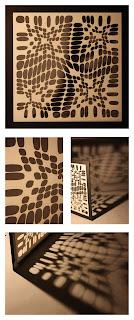These texture studies are a way to experiment with designing texture that is embedded within a material as a way to discuss ornament. The intent is to combine the texture studies with the screen studies in a final screen, using the texture where material has not been completely removed. The final piece will be cut out of plywood, taking advantage of the different colors of the layers that comprise the plywood. These studies result in a flat look when there is no direct sun, and the added color of the wood will create more variation in the textures when sunlight is limited. The textures were designed using Grasshopper in Rhino as well as height fields in Rhino and cut out of MDF.
Monday, November 28, 2011
Wednesday, November 16, 2011
Screen Studies
This is a continuation of the earlier screen studies. These screens begin to look at not removing as much material and designing areas where a person may not be able to see through the screen. A possible application for this would be to design privacy in certain areas and allow for direct visual access in others.
Sunday, November 13, 2011
Knife Cutter
This is a current group project in our Digital Fabrication course. We are researching the curved crease to generate forms out of .02 PETG. We finally got the knew knife cutter in the fab lab and had it up and cutting for us the day after we were trained! The tool that does the creasing for us doesn't cut anything, just presses into the material and the PETG folds up really easily afterwords. This particular form works through some of our connection and assembly issues before we get moving on the large installation (still to be designed). This project in is collaboration with John Hilmes, Bennett Scorcia and Matthew Strong.
Monday, November 7, 2011
Screen Studies
This is a series of screen studies with different patterns intended to create various shadows and areas of greater or less density in the pattern. The study will be used to create a larger structure which will use varying densities in the pattern to create privacy and allow light to pass through. The screens also begin to become three dimensional depending on the manipulation of the material.
This set of screens uses the same pattern which has been slightly offset three times. Each screen set adds one additional layer of the pattern, and the final screen has rotated the pattern creating more density in the screen.
Tuesday, November 1, 2011
Python Scripting
This was a short exercise to get us familiar with a few functions in Python Scripting. Collectively, a base script was written and then individually modified to create a unique paneling system on a surface generated in Rhino.
Subscribe to:
Posts (Atom)






















